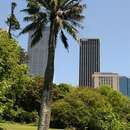en
names in breadcrumbs


Jubaea is a genus of palms with one species, Jubaea chilensis or Jubaea spectabilis, commonly known in English as the Chilean wine palm or Chile cocopalm, and palma chilena[3] in Spanish. It is native to southwestern South America and is endemic to a small area of central Chile between 32°S and 35°S in southern Coquimbo, Valparaíso, Santiago, O'Higgins, and northern Maule regions.
It has long been assumed that the extinct palm tree of Easter Island belonged to this genus as well; however, in 2008, John Dransfield controversially placed it in its own genus, Paschalococos.
In its area of natural distribution young Jubaea's tend to grow near adult specimens, preferring also sunny and vegetated sites.[4]
The thickest well-documented Jubaea was on the estate of J. Harrison Wright in Riverside, California. Its diameter "at shoulder height" was 66 inches (1.7 m).[5] The largest of several specimens at the Adelaide (South Australia) Botanic Garden in 1889 was stated to be 6 feet (1.8 m) thick at the base.[6] A hollow (but living) Jubaea in the Ocoa Valley near La Campana National Park, Chile is 6 to 7 feet (1.8 to 2.1 m) thick at its base, with no apparent taper in the lower trunk.[7] The largest individual specimen of indoor plant in the world was the Jubaea chilensis at Kew Gardens, which was cut off by staff in 2014 because it grew to the top of its greenhouse.[8] Of the more than 2,600 known species of palms, Jubaea chilensis is the second most massive, exceeded only by the floodplain or river bottom variety of Borassus aethiopum.[9]
The leaves can be used to weave baskets, and it has edible seeds. The sap can be used to make palm wine and palm syrup, although unlike other palms which can be tapped, the whole tree has to be felled; this is now restricted by legal protection.[10]
The species is partially protected within Chile, although pressures of human population growth and expansion of grazing areas have reduced the population of the Chilean wine palm in recent centuries.[11] The collection of its seed and their predation by Common degu may also have a negative impact for the growth of new generations of Jubea.[4] The IUCN Red List considers the palm Endangered.
Charles Darwin examined these trees on visiting Chile in 1832 on the second voyage of HMS Beagle and noted:
These palms are, for their family, ugly trees. Their trunk is very large, and of a curious form, being thicker in the middle than at the base or top.[10]
In 1843, a specimen was grown from seed at Kew Gardens in London, and was moved into the Temperate House in 1863, eventually growing to 19 metres (62 ft). It was believed to be the world's tallest indoor plant, until it had to be felled in 2013 because it had outgrown the space available and could not be moved. It has been replaced by seedlings from the original tree.[12]
World-record Jubaea at Kew Gardens
Jubaea chilensis in Leverkusen, Germany
Jubaea chilensis growing in Goleta, California
Painting of a Jubaea by Chilean artist Onofre Jarpa
Jubaea is a genus of palms with one species, Jubaea chilensis or Jubaea spectabilis, commonly known in English as the Chilean wine palm or Chile cocopalm, and palma chilena in Spanish. It is native to southwestern South America and is endemic to a small area of central Chile between 32°S and 35°S in southern Coquimbo, Valparaíso, Santiago, O'Higgins, and northern Maule regions.
It has long been assumed that the extinct palm tree of Easter Island belonged to this genus as well; however, in 2008, John Dransfield controversially placed it in its own genus, Paschalococos.